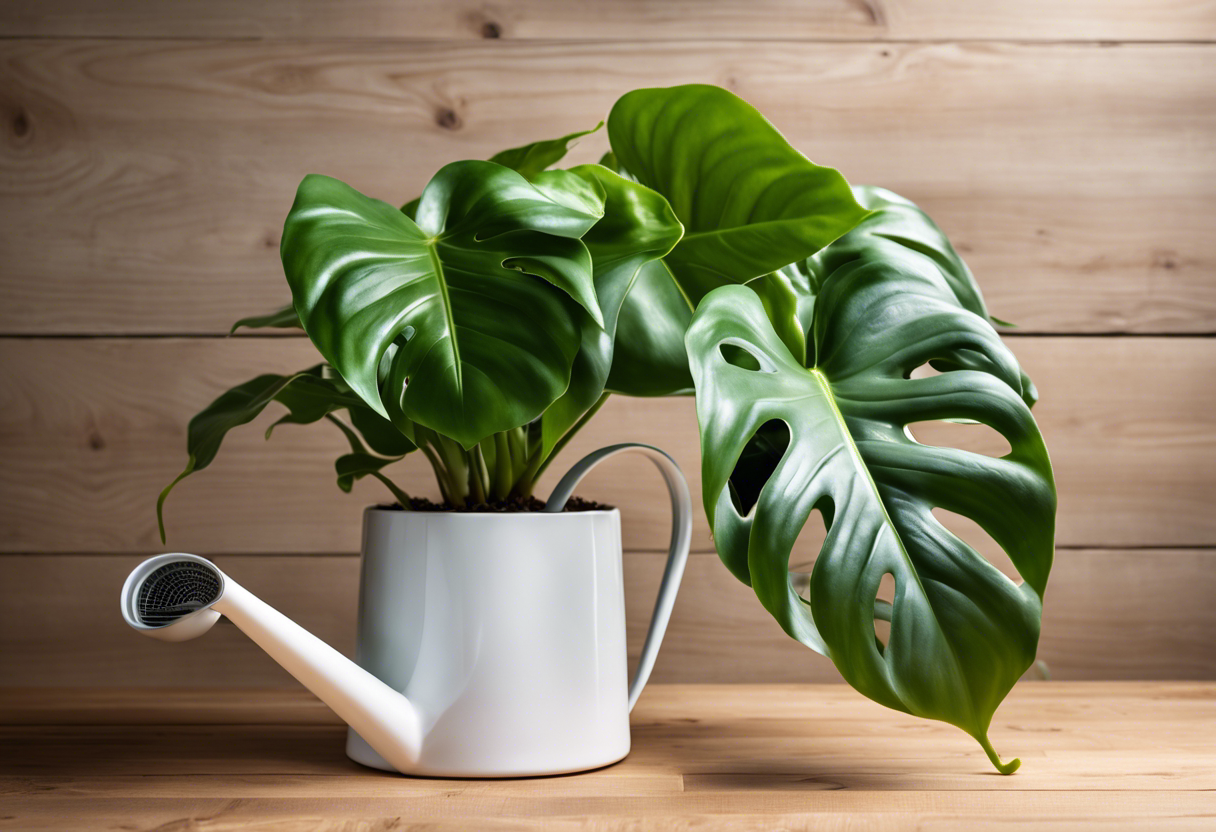Ever found yourself staring at your beloved philodendron, watering can in hand, wondering How Often and How Much to Water Philodendrons? You’re not alone. It’s like trying to figure out how many chocolates are too many – a delicate balance between indulgence and overkill.
Now, you might think it’s as simple as pouring some water and calling it a day. But trust me, these leafy buddies have their quirks. So buckle up, plant-parents! We’re diving into the world of philodendron hydration. Keep reading about How Often and How Much to Water Philodendrons.
Key Takeaways
- Philodendrons should be watered once a week during the growing season (spring and summer) and every two weeks during dormant periods (fall and winter).
- The amount of water depends on the plant’s size, but generally, it should be enough to make the soil moist without waterlogging.
- Overwatering can lead to root rot, while underwatering can cause leaves to yellow or wilt.
- Adjust watering frequency based on environmental factors like temperature, humidity, and light exposure.
Understanding Philodendrons
Philodendrons, originating from the tropical Americas, have become one of the most popular houseplants worldwide. Their popularity stems from their adaptability and resilience, making them perfect for indoor settings. But here’s a fun fact: not all philodendrons are created equal! Yep, there are different types of these leafy beauties, each with its own unique watering needs.
What are Philodendrons?
So what exactly are these green buddies? Well, philodendrons are tropical plants known for their lush foliage and easy-to-care-for nature. They’re like that low-maintenance friend who’s always up for a good time but never causes any drama. And just like that friend, they can brighten up any space!
Why do they make such great houseplants? For starters, they’re pretty forgiving. Even if you forget to water them once in a while (not that we’re encouraging plant neglect here), they won’t hold it against you. Plus, their characteristics make them ideal indoor plants, as they can thrive in lower light conditions and don’t require constant attention.
Different Types of Philodendrons and Their Watering Needs
Now onto the juicy stuff – the different types of philodendrons and how much H2O each type needs. You see, some varieties prefer their soil to be on the drier side (like the Philodendron Xanadu), while others enjoy a more moist environment (like the Heartleaf Philodendron).
It’s all about understanding your specific type’s watering preferences. This is where knowing your plant comes into play – it’s not just about watering; it’s about watering right! So whether you’ve got a climbing Philodendron or an upright variety sitting on your windowsill, remember this golden rule: when it comes to how often and how much to water philodendrons, it’s all about balance. Too little and they’ll dry out; too much and you risk root rot. It’s a delicate dance, my friends!
How Often to Water Philodendrons
When it comes to how often and how much to water philodendrons, there’s no one-size-fits-all answer. It depends on a variety of factors like the type of philodendron, seasonal changes, and whether you’re growing it indoors or outdoors. But don’t worry! We’ll dive into all these aspects of philodendron care.
Factors Influencing Watering Frequency
The frequency of watering philodendrons isn’t set in stone. It can change based on several factors. Understanding these plant care variables will help you adjust your watering schedule to meet your plant’s hydration needs.
Type of Philodendron
Not all philodendrons are created equal! Different types have different watering needs. Some might be thirsty fellas needing frequent watering, while others prefer being on the drier side. So, knowing your specific type is crucial for its specific plant water needs.
Seasonal Changes
Just like us humans, philodendrons’ hydration needs change with the seasons. In warmer months they might need more water, while in cooler ones less so. Being aware of these seasonal plant care changes can help keep your leafy buddy happy year-round!
Indoor vs Outdoor Growth
Whether your philo buddy is chilling inside or basking outside also affects its watering needs. Indoor plants generally need less water than their outdoor counterparts due to lower light and humidity levels. So remember to adjust your watering according to the location for optimal location-based plant needs!
How Much to Water Philodendrons
When it comes to philodendron care, there’s a bit of an art to figuring out how much to water philodendrons. It’s not just about pouring in H2O willy-nilly. Nope, you’ve got to consider factors like the plant’s size and age, and the soil type and drainage.
Determining the Right Amount of Water
So how do you know when your leafy buddy is parched or drowning? Well, your philodendron will give you signs. If it’s thirsty, the leaves might droop or turn yellow. On the flip side, if it’s overwatered, you might see root rot or mold. So keep an eye on these indoor plant hydration cues.
Size and Age of the Plant
Now let’s talk about size and age because they matter too! A baby philodendron won’t drink as much as its grown-up counterparts. So when it comes to watering young vs mature philodendrons, remember that less is more for the youngsters.
Soil Type and Drainage
And finally, we can’t forget about soil type and drainage. The best soil for hydrating plants is one that drains well but retains some moisture – think Goldilocks, not too dry, not too wet! And remember folks, good drainage is crucial in preventing overwatering – nobody wants a soggy philodendron!
Signs You’re Overwatering or Underwatering Your Philodendron
Proper watering is a biggie in Philodendron care. Too much or too little can lead to some not-so-pretty symptoms. But don’t worry! We’ll dive into the signs of overwatering and underwatering next.
Symptoms of Overwatering
So, your Philodendron’s leaves are turning yellow? It might be getting too much H2O. Overwatered Philodendron symptoms often include leaf yellowing and a soggy feel to the plant.
Excess water can cause damage, leading to root rot in plants. This isn’t just a bad hair day for your plant; it’s serious stuff that can affect its overall health.
Symptoms of Underwatering
On the flip side, if your Philodendron looks like it’s wilting, it might be thirsty. Underwatered Philodendron symptoms typically involve wilting leaves and dry soil.
Long-term, this drought stress can seriously impact your plant’s growth and vitality. So remember, when it comes to how often and how much to water Philodendrons, balance is key!
Tips for Properly Watering Your Philodendron
Proper watering techniques are the heart of philodendron care. It’s not just about watering philodendrons, but also about when and how you do it. Let’s dive into the nitty-gritty of indoor plant watering, especially focusing on our leafy friend, the Philodendron.
Best Time to Water Your Plant
The best time to water your philodendron is early morning or late evening. Why? Well, these times allow the water to slowly seep into the soil and reach the roots without quickly evaporating due to heat.
This watering schedule for philodendrons can significantly affect their health. If you’re watering at optimal times, your plant will be singing “I’m walking on sunshine” instead of wilting away in despair.
Remember, timing is everything! The effects of watering timing on plants can’t be overstated. So set that alarm and make your philodendron a happy camper!
Using the Right Tools for Watering
Now let’s talk tools. A good old-fashioned watering can works wonders for watering tools for plants. It provides a gentle shower that mimics rain – exactly what our tropical pal loves!
But why stop there? Consider using a moisture meter too. This handy tool takes guesswork out of indoor plant watering by telling you when your plant is thirsty.
And don’t forget about drainage! Using a pot with proper drainage holes prevents water from sitting at the bottom and causing root rot – a surefire way to send your philodendron to plant heaven.
So folks, remember: use the right tools, keep an eye on timing, and you’ll master how often and how much to water philodendrons in no time!
To Wrap Up
So, we’ve been on quite a journey, learning How Often and How Much to Water Philodendrons. It’s like being a bartender for your plants – too much water and they’re staggering around, too little and they’re parched.
Remember, it’s all about balance and reading the room (or rather, the leaves). So keep that watering can handy but don’t go overboard. Your philodendron will thank you!





